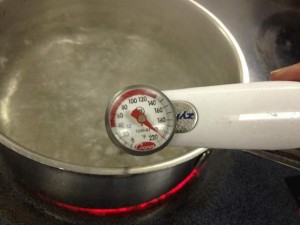Susan Selasky of the Detroit Free Press writes in the Free Press Test Kitchen Tip how to calibrate a crappy bimetallic stem thermometer.
If the thermometer starts at 0 degrees, make an ice slush using crushed ice and water in a average drinking glass. Find the small indentation (usually about 1½ inches from the pointed end) and place in the ice slush so the indentation is covered. Don’t let the thermometer touch the bottom or the sides. Wait a minute or 2 and when the needle is steady it should register 32 degrees. If not, adjust the nut on the back of the dial using pliers until it reads 32 degrees.
For thermometers that start at higher temperatures, bring at least 3 inches of water to a boil. Place the thermometer stem in the water so the indentation is covered; use tongs to hold it steady. When the needle is steady, it should register 212 degrees. If not, adjust the nut.
I prefer the digital, tip-sensitive thermometers that don’t have nuts and get messed up readings every time they are dropped. And as thermometer guru Pete Snyder wrote ten years ago bimetallic stem thermometers aren’t all that accurate. My thermometer of choice, the Comark PDT 300’s calibration steps are here – and like most digital thermometers it can be reset in one step.
